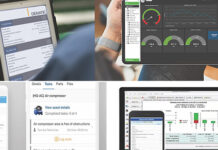 This article from the manager of stadium operations of Camden Yards in Baltimore, MD shares insights on how he and his staff are maximizing the power of their CMMS.
This article from the manager of stadium operations of Camden Yards in Baltimore, MD shares insights on how he and his staff are maximizing the power of their CMMS.
Do you use a CMMS for your facilities, and are you deriving the maximum benefit?
By Matthew Kastel
Over the course of several years, we at the Maryland Stadium Authority (home of Oriole Park at Camden Yards, and the M&T Bank Stadium), had become dependent on our CMMS (computerized maintenance management system) to help keep our stadium world-class and to maximize productivity. So you can imagine the urgency we felt when we learned the company we purchased it from was no longer going to support the software. This led us on a challenging venture that led us in 2014 to purchase a new web-based CMMS that provided the tools we need to succeed in the future. Along the way we learned a lot…
For those who don’t know, CMMS were originally developed to help manage medical facilities and equipment in the late 1970s. As the performance of facilities and equipment in medical settings is, literally, a matter of life and death, it is not surprising that a computerized system that monitors maintenance and repairs quickly caught on.
Soon, other large facilities and industries recognized the benefits of tracking preventive maintenance, repairs, and employee work schedules and related costs via a CMMS. Recently CMMS has become modus operandi for public assembly venues. Today it is no longer possible to run a world-class venue without first having a world-class CMMS. That being said, as this is still a fairly new piece of technology to many public assembly venues, it is often not used to its full extent, and like any tool, the CMMS needs to be run correctly or else a precious resource is squandered. Below are some tips that will enable facility management teams to get the most out of this investment.

More Than Just Incident Tracking
The number one mistake public assembly venues make is underutilizing the capacity of their CMMS. It is hard to believe that many venues still treat the CMMS solely as a way to track incidents during events and/or games. Although this is a legitimate function, it is akin to having a calculator and only using it for addition, and opting to do division, subtraction, and multiplication with pen and paper.
A CMMS core function is to help manage preventive maintenance more efficiently. It is no coincidence that if the CMMS is used to its maximum efficiency, you’ll also notice a drop in incidents during events that venue managers find important to track.
This lesson became evident to us when we appeared to have a high number of maintenance calls on our escalators. To combat this trend, we loaded in a detailed maintenance plan for our escalators that included when our contractors were to service them, and detailing the exact steps of preventive maintenance they needed to take. Not only did this improve communication with our vertical transportation contractor, but we saw a reduction in shutdowns during our games which helped not only our guest experience, but also saved us thousands of dollars in overtime repairs.
Garbage In, Garbage Out
Garbage in garbage out certainly is not a new phrase and one with which we are all familiar. Still, it is worth remembering that failure to follow this axiom will doom your chances of success.
Do you have a complete equipment list loaded into your CMMS? Do you have the proper maintenance steps tied into the equipment list? Are the frequencies of servicing each piece of equipment accurate, and does it assign a realistic amount of time to do the maintenance? Are your technicians keeping good notes and properly entering them into the system?
Initially, we overestimated the amount of time it took to do some basic electronic and hardware preventive maintenance. For that reason we loaded into our weekly staff’s schedules, via our CMMS, too much slack time in getting certain projects done. Because of this we weren’t as productive as we should have been, and planning future work was done unscientifically. Once we rectified this by putting in accurate information rather than “garbage”, planning future work became more predictable and reliable.
A CMMS can do many things, but, at the end of the day, it tracks and stores key information to help you manage your venue properly. This will only work if reliable data is being entered.
Planned Rather Demand
One of the key cultural shifts that need to be made to make the CMMS successful is to get away from the demand/fixed mentality and into a preventive maintenance mentality.
If your maintenance staff spends its whole day being firemen putting out fires (responding to demand maintenance calls), your venue will never become proactive, and maintenance problems will multiply as the maintenance staff will not have the proper time for preventive maintenance.
This is exactly what our maintenance staff’s mentality was, and it was a hard habit to break. Psychologically it is more rewarding to do break/fix work than preventative maintenance. When something breaks and you stop everything to fix it, you are bound to get praise from those who reported the breakage, where preventive maintenance is done behind the scenes, and praise is less often given to the maintenance worker who accomplishes it.
It was important to express to our maintenance staff how important it is to stay on top of preventive maintenance and praise them when it was done in a timely basis. Once that happened, it opened the door to having a preventive maintenance mindset.
A CMMS will help lay out what preventive maintenance needs to be done each month (planned work). Once this becomes a priority, demand work can be completed based on its priority and availability of staff.
By using the CMMS to make preventive maintenance your focal point, you can extend your facility and its equipment’s lifespan by years and save on long term costs, as you will have less break/fix situations.
Maintenance Planning Meeting
Another important component to being successful is to have a regularly scheduled maintenance planning meeting. This can be done weekly or monthly, depending on the size of the venue.
In this meeting your maintenance planner (CMMS coordinator) should meet with the facility manager and perhaps the head of the individual trades: electric, mechanical, AV, plumbing, etc.
During this meeting a plan of action needs to take shape about what maintenance work needs to be done in the upcoming period, what obstacles lay ahead in getting this work done, and what, if any, adjustments need to be made. By the end of the meeting everyone will have a clear idea of what the priorities are for that month.
The maintenance planning meeting is also the ideal time to discuss any outstanding work orders and find out why they are delayed in getting done. The regularly planned maintenance meeting must have a sense of urgency, and it must be stressed to all that getting done what has been laid out in the CMMS is absolutely critical to the facility.
At first, our staff struggled with this concept. In a stadium our size there are always a million things that need to be done. The last thing our supervisors wanted — especially on a game day — was yet another meeting. It wasn’t till we made clear that our maintenance planning meeting wasn’t just another meeting — but that it was the core of who we are and how we planned to operate — did we begin to see progress.
Now game day or not, when it is time for our planning meeting it happens without question and all our supervisors participate. This has helped foster a shared vision on what needs to be done and what our priorities ought to be.
Show Me The Money
Like any bit of technology, every day there seems to be a new CMMS coming out with enhanced applications. Today, most offer much more beyond managing preventive maintenance and repairs. Cost control is a big component of CMMS, allowing for everything the maintenance team does to be tracked to the penny. Labor costs and materials can be easily tied into specific projects and budgets or for charge backs, providing accurate real-time information about what projects and tasks cost.
Also, many CMMS can help you manage storeroom inventory, track leases, set employee schedules, and manage contractors. When buying a CMMS it is important not only to get a system that fits your venue but also fits the type of venue you want to be in the next five to 10 years.
When we bought our present CMMS we made the conscious decision to make this system the headquarters for our procurement process. From approvals, to securing paperwork to making sure new contracts are entered and followed correctly, our CMMS is our one stop shop. By doing this, we’ve saved many hours of having to look through various documents when we needed to question details of an old procurement or contract. Now, it is always just a few clicks away on a keyboard. This increased efficiency has saved us countless dollars in key manager’s opportunity costs as their time is no longer wasted going through reams of old paperwork scattered in various locations.
By following these basic tips, you will be well on the way to making your venue more productive, efficient, and economical — allowing you to provide the type of service that is expected by your stakeholders and guests.
 Kastel is the manager of stadium operations at Oriole Park at Camden Yards in Baltimore, MD for the Maryland Stadium Authority. He is a veteran of managing large public facilities, including The Astrodome, Citizen’s Bank Park, and Washington D.C. Convention Center. Kastel also sits on the Board of Visitors for the Bolte School of Business at Mount St. Mary’s University, where he teaches a graduate class on sports facilities and events.
Kastel is the manager of stadium operations at Oriole Park at Camden Yards in Baltimore, MD for the Maryland Stadium Authority. He is a veteran of managing large public facilities, including The Astrodome, Citizen’s Bank Park, and Washington D.C. Convention Center. Kastel also sits on the Board of Visitors for the Bolte School of Business at Mount St. Mary’s University, where he teaches a graduate class on sports facilities and events.

















 This article from the manager of stadium operations of Camden Yards in Baltimore, MD shares insights on how he and his staff are maximizing the power of their CMMS.
This article from the manager of stadium operations of Camden Yards in Baltimore, MD shares insights on how he and his staff are maximizing the power of their CMMS.







![[VIDEO] Collect Asset Data at the Speed of Walking a Building](https://facilityexecutive.com/wp-content/uploads/2024/02/maxresdefault-324x160.jpg)